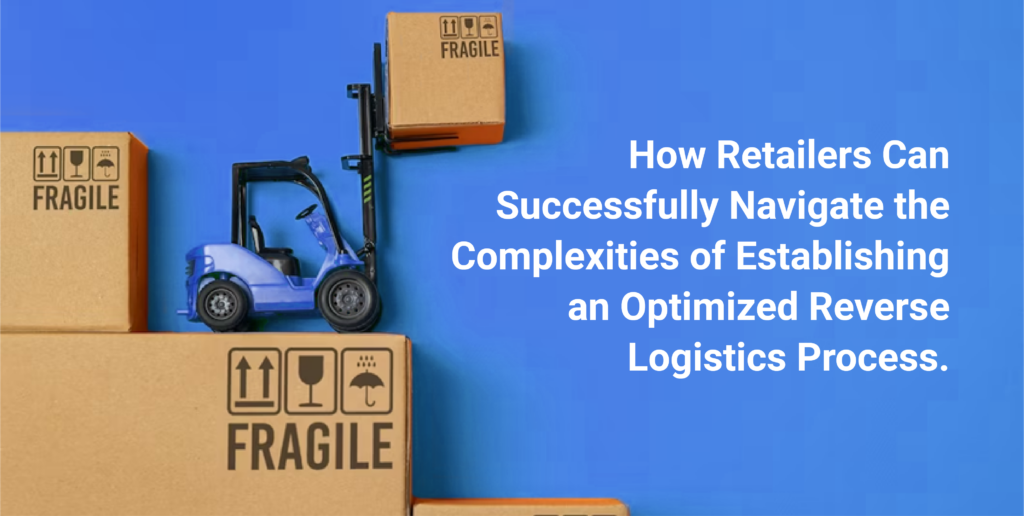How online retailers can successfully navigate the complexities of establishing an optimized reverse logistics process.
Any e-commerce brand that offers their customers returns will know that hassle-free returns strategies are never simple. In this post, we take a look at what is reverse logistics, the main reverse logistics problems in ecommerce that need to be overcome including root causes caused by changes in consumer behaviour.
Let’s say you’ve got an upcoming black-tie event and are in urgent need of a new outfit. You log on to your favorite online retailer to find that they’ve got the perfect piece in stock only there’s a small problem, you’ve encountered issues with sizing in the past and aren’t sure which one to go with. Luckily, the brand has multiple sizes in stock so you order the same outfit in several sizes to try on once they get delivered to return the ones that don’t fit.
This process, called bracketing, became more widespread during the pandemic as customers were unable to hit the stores to try on clothes. Trying on different sizes is standard practice when shopping in person, and retail locations are adequately equipped to handle this process with ease. However, for many digitally native brands, if their supply chain is not prepared to handle multiple simultaneous returns, it can create a tremendous problem. To avoid this, more brands are adopting a reverse logistics or aftermarket supply chain strategy.
The higher volume of returns for online purchases combined with the continual growth trajectory of e-commerce will continue fuelling the reverse logistics market. According to the US-based National Retail Federation, for every one billion dollars worth of sales a brand makes, it’s estimated that $165 million worth of merchandise is returned—so much so that in 2022, over $800 billion worth of products found their way back to brands from consumers. When specifically looking at the difference between in-person purchases and those done through e-commerce, between 20 – 30% of products sold online are returned compared to only 10% of in-store purchases.
Nowadays, for every e-commerce brand, incorporating reverse logistics strategies into their supply chain is just as important as the products they sell.
What is Reverse Logistics?
Reverse logistics refers to a defined set of processes that are conducted after a product has been sold. Starting at the end of the traditional linear supply chain (the end consumer), an aftermarket supply chain works its way backward down the line with the product being returned to the manufacturer directly or via a distributor or sending it forward for refurbishing or recycling. This creates a loop in the supply chain with the flow of goods moving continuously back and forth between manufacturer and consumer via the distributor.
This set of reverse logistics processes is commonly referred to as the 5 Rs—Returns & exchanges, Reselling returned products, Repairs, Recycling & disposal, and Replacements. One mainstream example of a reverse supply chain in action can be seen in Swedish retail giant H&M. H&M allows customers to return items of clothing from any brand for recycling. Customers are incentivized through a sense of environmental responsibility as well as rewarded with coupons for a discount on their next purchase. The collected garments are returned to H&M’s manufacturing facility where the textiles are broken down into new fibers to create their recycled apparel line which is then sold in stores and online.
As the above example shows, a reverse logistics strategy plays a crucial role in the circular economy. The returned goods recoup some of their monetary value and minimize the impact of new raw materials from entering the supply chain. Not only does this sustainable approach to logistics create value for the business by minimizing returns-related losses, reducing business-related environmental impact, and turning waste into sales, but it’s also an excellent approach to building customer trust and loyalty as well as keeping down costs associated with storage and distribution.

Optimal Deployment
Deploying an optimized reverse logistics strategy is essential from the get-go and can be quite simple provided e-commerce merchants have the right supply chain infrastructure and supply chain software. Equipped with these, the returns are processed in much the same way as any package in the brand’s forward logistics strategy. Barcodes and scanners are used for tracking and processing, material handling systems are used to move and store the goods whilst Electronic Data Interchange (EDI) or integrated supply chain software enables the flow of information across vendors, suppliers, and stakeholders
Typically, the reverse logistics process follows the following steps:
- Processing – This is where returns are authorized and the product’s condition is validated. Customer refunds, scheduling the return shipment, or replacing faulty goods also happen here.
- Handling – Once processing is over, the returns arrive back at the returns center for inspection to determine which return category it falls into – repair, refurbish, or disposal. Once validated, the return is then sorted according to where it will go next.
- Movement – The returns are then transported to their next destination with a daily flow of returns being moved onward.
- Repair – Returns that have been identified to be in adequate condition for repair are refurbished for resale.
- Recycle – Returns are stripped apart for their raw materials to be used in the manufacturing process minimizing the need to extract new raw materials.
These processes can be optimized through planning management and execution. For example, an optimized reverse logistics strategy would already know where the returned product is going, thus eliminating much of the handling step. Optimized reverse logistics not only produce greater financial returns for the company, but they also lead to greater visibility over supply chain operations, and of course, with greater visibility come benefits such as improved brand sentiment, faster and better customer service, improved waste reduction, and greater progress toward ESG goals.
The 5 Rs of Reverse Logistics
All 5 Rs of reverse logistics have metrics that can be applied to track the reverse strategy’s success and to find areas for improvement with the most important metrics that merchants will want to track being:
- Volume
- Percent of Costs
- Product Condition
- Financial Value
- Errors
Furthermore, data collected from customers after delivery is advantageous as it provides insights into supply chain performance, and identifies opportunities for improvement and optimization—all of which can be used to improve the customer experience.
Reverse Logistics Strategic Insights
Incorporating reverse logistics into a supply chain strategy without a doubt adds a layer of complexity through an additional stream of goods that needs to be monitored. As with any initiative, there will always be obstacles that supply chain professionals need to overcome and continuously finetune in order to make their action plan a success.
One of the first things that merchants will need to do is to ensure that they have adequate supply chain infrastructure in place that is capable of tracking the flow of goods in a bi-directional manner. This is so that a holistic view of both inbound and outbound shipments can effectively be drawn. A simple way to track is to deploy a logistics system that integrates ERPs, WMS, inventory systems, and other supply chain components to ensure that efficiency and operations can be monitored in real-time.
Logistics systems have matured to the point that they are now capable of automating many manual processes involved in supply chains. By partnering with the right logistics software provider, companies will be able to put many supply chain processes on autopilot. For example, systems from leading technology providers can auto-generate returns labels, arrange return shipment routes, validate returns orders, provide comprehensive real-time analytics, and much much more.
Another way to enhance the effectiveness of the reverse strategy would be to centralize the return location. This would aid in streamlining operations as all returns will be processed in one location, and not only that, it will also reduce shipping costs.
To further abate shipping costs associated with reverse shipments, merchants may want to consider outsourcing their returns services to a 3PL. 3PLs usually have expansive transportation networks with access to preferential rates enabling them to capture returns from a wider area at a lower cost. 3PLs also can act as an intermediary storage facility by helping to aggregate a commercially viable amount of products in a location closer to the end consumers. Goods collected here can then be consolidated into a bulk shipment back to the centralized return location.
Conclusion
The momentum behind reverse logistics will not die down anytime soon. As more consumers shop online, so too will the number of products that need to be returned to merchants increase. It is essential that thorough strategic planning occurs to ensure that brands are logistically equipped to handle the influx of returns. Deploying an optimized reverse logistics strategy powered by the right technology platform and working alongside logistics services providers are resources retailers can leverage to their advantage. By mapping out a clear reverse logistics process, brands will be rewarded with financial returns, generate tremendous value, and seamless shopping experiences for their customers.

Ready To Upgrade Your Logistic Solution?
Speak to Floship ecommerce logistic consultant about improving your global support chain today




